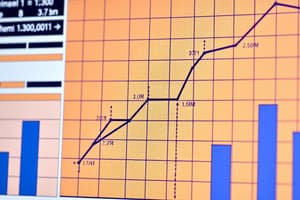Podcast
Questions and Answers
What is the purpose of regression analysis?
What is the purpose of regression analysis?
To model relationships between variables.
Explain the concept behind hypothesis testing.
Explain the concept behind hypothesis testing.
To determine if observed findings are due to chance or a real effect.
How does inferential statistics differ from descriptive statistics?
How does inferential statistics differ from descriptive statistics?
Inferential statistics uses samples to draw conclusions about populations, while descriptive statistics only describe the data.
Give an example of a situation where probability is used.
Give an example of a situation where probability is used.
Why are confidence intervals important in inferential statistics?
Why are confidence intervals important in inferential statistics?
What is the main purpose of descriptive statistics?
What is the main purpose of descriptive statistics?
Name three commonly used measures in descriptive statistics to describe central tendency and variability.
Name three commonly used measures in descriptive statistics to describe central tendency and variability.
How does probability theory help in decision-making?
How does probability theory help in decision-making?
Define regression analysis in statistics.
Define regression analysis in statistics.
What is the purpose of hypothesis testing?
What is the purpose of hypothesis testing?
Study Notes
Introduction to Statistics
Statistics is a powerful tool used by scientists, researchers, and businesses to make informed decisions based on data. It involves collecting, analyzing, interpreting, and presenting numerical information related to measurable characteristics of populations. In this discussion, we will explore several key areas within statistics such as descriptive statistics, probability theory, regression analysis, hypothesis testing, and inferential statistics. These concepts form the foundation upon which statistical methods can be applied across various fields.
Descriptive Statistics
Descriptive statistics helps us summarize large amounts of raw data into understandable formats like tables or charts. This makes it easier to identify patterns and relationships within the dataset. For instance, mean, median, mode, range, standard deviation, and quartiles are all commonly used measures to describe central tendency, dispersion, and variability of a set of data points. By using these summary statistics, we can gain insights without having to examine each individual piece of data.
Probability Theory
Probability plays a critical role in understanding risk and chance. It deals with uncertain outcomes and provides a framework for expressing the likelihood of events occurring. Essentially, probability quantifies how likely something is to happen. For example, when tossing a fair coin twice, there's a 0.25 (or 1 out of 4) chance you get two heads; whereas flipping four coins simultaneously has only one possible outcome—four heads or four tails—so its probability is either zero or one.
Regression Analysis
Regression analysis allows us to model relationships between variables. Typically, there are two kinds: linear regression where one variable varies linearly over another, often represented by a straight line on a graph; and nonlinear regression where the relationship isn't so simple. A prominent application is predicting house prices based on features like square footage, number of bedrooms, etc., which may follow complex curved patterns rather than strictly linear ones.
Hypothesis Testing
Hypothesis tests help determine whether observed findings could have happened purely due to random chance or if there's evidence suggesting they stem from some real effect present in reality. These tests involve setting up null hypotheses (which assume nothing exists beyond what would occur naturally), constructing test statistic(s) based on the sample data collected under this assumption, deriving p-values representing probabilities associated with obtaining results equal to or more extreme than those actually obtained given that the null hypothesis were true, comparing these values against predetermined significance levels a priori chosen by experimenters before running any analyses...and finally drawing conclusions accordingly.
Inferential Statistics
Inferential statistics uses samples to draw conclusions about larger groups called populations: Election pollsters estimate national vote counts using surveys conducted among relatively small portions of registered voters; biologists might gather blood pressure measurements from five rats and generalise their findings to other members of the species. This process relies heavily on sampling distributions – sets containing every possible total value your sample mean could achieve after repeatedly taking new samples of identical sizes from your population - and confidence intervals which indicate ranges around sample estimates reflecting plausible bounds for 'true' population parameters.
In conclusion, understanding descriptive statistics, probability, regression analysis, hypothesis testing, and inferential statistics are vital skills for anyone working with data. They allow us to organize, interpret, question, and extrapolate meaning from our observations - tools essential in today's world saturated with information.
Studying That Suits You
Use AI to generate personalized quizzes and flashcards to suit your learning preferences.
Description
Explore the foundational concepts of statistics including descriptive statistics, probability theory, regression analysis, and hypothesis testing. Learn how to summarize data, assess probabilities, model relationships between variables, and test hypotheses to make informed decisions based on data.




